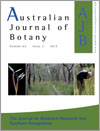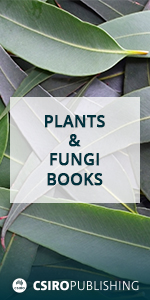Australian Journal of Botany
Volume 65
Number 2 2017
The grasslands of temperate Australia seem to require disturbance to maintain species diversity. Grasslands in semiarid environments do not seem to have the same requirement. This short-term study suggests that subtropical grasslands on the Darling Downs do not have a requirement for disturbance to maintain species diversity. Drought in the subtropical environment may maintain grasslands in a sufficiently open structure to overcome the requirement for disturbance to maintain diversity of the intertussock flora.
Four small Australian desert succulents respond to drought by switching from CO2 uptake in the light to CO2 uptake in the dark. Uptake of CO2 in the dark enables plants to persist at low water-cost, thereby potentially aiding reproduction. The ability to switch between photosynthetic pathways is a trait that may be more common within Australia’s flora than considered previously.
In arid Australia, the survival of a white cypress-pine seedling to maturity is rare. We found that fencing, particularly rabbit-proof fencing, resulted in increased numbers of white cypress-pine seedlings – but not at all sites. While protection from grazing is important for seedling survival, the potential for other factors to intervene means that rabbit-proof fencing does not guarantee the next generation of white cypress-pines.
Genome multiplication (polyploidy) is an important phenomenon in plant evolution and has significant implications for conservation and ecological restoration. We studied genome multiplication in a group of rare sedges (the Lepidosperma costale species complex) in south-west Western Australia. Four ploidy levels were discovered, suggesting that polyploidy may be an important driver of diversification in these sedges.
Gahnia radula is an important species of sedge needed for vegetation restoration. To understand the extent and source of genetic variation in this species in southern Australia, variation within different populations of the species was investigated. Knowledge gained from the study indicates a prevalence of asexual reproduction and supports recommendations for areas suitable for sourcing material for revegetation.
Population genetics is a key element for the conservation of endangered plant species. The comparison of two congeneric species of Scaevola in New Caledonia, one widespread and one narrow endemic, indicates high differentiation between populations, especially for the narrow endemic species on very small geographical scale. These results demonstrated the importance of conserving multiple populations of narrow endemic species even when they co-occur in close proximity.
Competition from neighbours can simultaneously favour increased dispersal and increased offspring provisioning (seed size), however, these functions trade-off with each other. We demonstrate a non-linear relationship between how fast seeds of wind dispersed Asteraceae species fall, and seed architecture (the size of the parachute like pappus versus the size of the ‘seed’). This non-linear relationship can be used to predict when plants allocate more to dispersal or provisioning when faced with intense competition.
Bark constitutes plant tissue that transports photosynthates and protects plants against pathogen attack, herbivore damage and high temperatures caused by Cerrado fires. Bark traits are directly related to fire protection in a fire-prone habitat and efficient photosynthate transport in a non-fire-prone habitat, with thicker rhytidome and wider sieve tubes respectively. Our study demonstrated that although bark anatomy is little studied, it offers rich diagnostic and adaptive information.
Eucalyptus plantations are replacing natural grasslands in South Brazil, and under these plantations few plants establish, but processes shaping this pattern have been scarcely investigated. We showed that Eucalyptus saligna releases chemical substances in leaf litter that inhibit germination and seedling growth of grassland species. Therefore, suppression of grassland vegetation under E. saligna plantations may be potentially related to effects of allelochemicals.
This work analysed the vegetation of gallery and savanna forest distributed in the lower Uruguay River basin. Plant associations of this vegetation type have been poorly studied. Plant communities are related to tropical forests of southern Brazil, but are present into a warmer climate zone because of the north–south corridor generated by the Uruguay River. Two new associations and a new alliance are described to add to the syntaxonomical scheme of Argentina, with the aim to improve the knowledge of the diversity of its plant communities.




